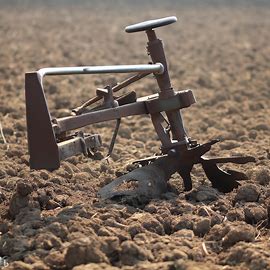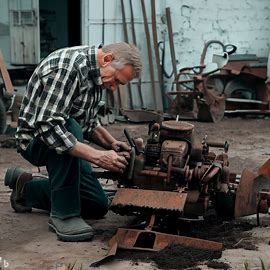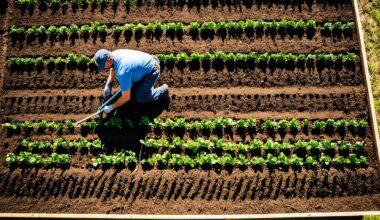I know what you’re thinking, “Hard ground? A tiller’s worst nightmare!” Well, let me tell you something – that’s a thing of the past. The drone-like humming of a stubborn tiller on unyielding earth is no longer an obstacle in our quest to create verdant landscapes out of hard-packed dirt.
Now imagine standing triumphantly over your conquered plot; sweat dripping off your brow but satisfaction washing over you like rain on parched land. That’s because we’ve figured out how to use a tiller on hard ground with elegance and efficiency.
So buckle up! We’re about to embark on an enlightening journey where we’ll unearth secrets that’ll transform your relationship with tough terrain forever. I promise by the end of this roller coaster ride; tilling hard ground will seem less daunting than before.
Choosing the Correct Tiller for Hard Ground

When it comes to tilling hard ground, having the right tool is crucial.
Not all tillers are created equal, and some are specifically designed to handle compacted soil.
Look for a tiller with powerful engine capabilities and sturdy tines that can penetrate tough ground.
Additionally, consider renting or purchasing a rear-tine tiller as they tend to provide better control and maneuverability in challenging terrain.
Preparing the Ground Before Tilling
Properly preparing your hard ground before using a tiller can make all the difference in achieving successful results.
Begin by removing any large rocks or debris from the area you plan to till, as these can damage your machine and hinder its performance.
Next, use a garden hoe or pickaxe to break up any compacted areas or clumps of soil. This will help create an even surface and allow your tiller’s tines to penetrate more easily.
Proper Use and Maintenance of a Tiller

Using a tiller on hard ground requires careful operation and regular maintenance. Start by familiarizing yourself with the manufacturer’s instructions for your specific model.
Always wear appropriate safety gear such as gloves, goggles, and sturdy footwear when operating machinery.
Regular maintenance is also essential for keeping your tiller running smoothly on difficult terrain.
Check the oil levels regularly and ensure they’re topped up according to manufacturer guidelines.
Also, inspect the tines for any signs of wear or damage, replacing them if necessary.
Operating a Tiller Safely on Hard Soil
Safety should always be prioritized when using gardening tools like a rototiller on solid ground. In order to avoid accidents and injuries, follow these tips:
- Be sure to check your surroundings and remove any obstacles that could interfere with the tiller’s path.
- Never start the machine without a clear understanding of how to operate it safely.
Correct Depth and Speed of Tillage on Solid Ground
Tilling at the proper depth is essential for breaking up hard ground effectively.
Begin by setting your tiller’s tines at a shallow depth and gradually increase as needed, avoiding excessive penetration that could damage underground utility lines or tree roots.
The ideal speed for tilling solid ground may vary depending on soil conditions; start slow and adjust accordingly to achieve optimal results.
Managing Difficult Areas When Using a Tiller
Hard ground may present challenging areas that require special attention when using a tiller. These can include rocky patches or compacted spots where regular tines struggle to penetrate effectively.
In such cases, consider using special attachments designed for tough terrains, such as hardened steel or carbide-tipped tines that provide extra durability and cutting power.
Caring for Your After-Tilled Soil

Once you have successfully used a tiller on hard ground, taking care of your newly tilled soil is crucial for future plant growth and overall garden health.
Start by removing any remaining debris from the area, such as large rocks or clumps of dirt.
Consider adding organic matter like compost or well-rotted manure to improve soil structure and fertility before planting crops or ornamental plants.
This will help retain moisture in the soil and promote healthy root development.
Conclusion
Having the right equipment and following these tips can make all the difference when it comes to tilling hard ground successfully.
Always choose a proper tiller suited to the terrain, maintain it regularly, and follow safety guidelines while operating. Be mindful of adjusting tiller depth and speed according to the rockiness or compactness of the soil.
Manage challenging areas with the appropriate attachments and ensure care for your soil after tilling to promote optimal plant growth.
With these essential tips in mind, you are set for a successful tilling experience even on hard ground.


